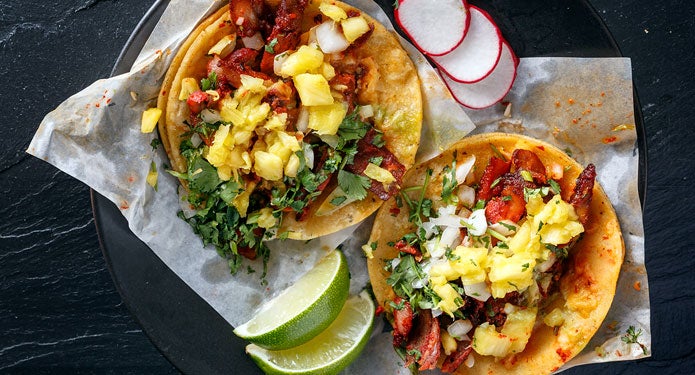Tips for creating lower calorie menu items.
As calorie counts make their way onto the menus of chain restaurants in Ontario (courtesy of the Healthy Menu Choices Act), and potentially across Canada, now might be a good time to look over your menu and lighten things up.
Though regulatory changes may be one reason to reduce the calorie counts, it’s certainly not the only one. There’s broader consumer awareness of health and wellness, driving a trend toward healthier eating that’s likely to live on for quite a while. Reducing calories now will align your menu with the better options customers are looking for, and place it ahead of any further regulatory changes, if they come.
Before you start cutting calories from your dishes, get reacquainted with what a calorie is and how different nutrients contribute to the overall calorie count. That way, you can tackle reductions in a strategic fashion.
What is a calorie?
A unit of the energy-producing value of food, a calorie is measured in kilocalories, or kcalories for short (calories and kcalories are used interchangeably). There are three macronutrients that produce the majority of energy for our bodies: carbohydrates, fat and protein. These three nutrients are not created equal. They each carry a different amount of calories, with carbohydrates and protein contributing 4 kcalories per gram, while fat contributes 9 kcalories per gram. So 10 grams of protein equals 40 kcalories. Ditto for 10 grams of carbs. But at 9 kcalories per gram, 10 grams of fat clocks in at 90 kcalories.
Based on this comparison, you can see that reducing the amount of fat in a recipe would have a bigger impact on the total calorie count than reducing the amount of carbs or protein. That said, fat contributes flavour and moisture, so eliminating all the fat could leave you with dry, bland and unpalatable food. Not appealing. The goal is to strike a balance, trimming calories while keeping the flavour. How? Consider reduction, substitution and preparation.
Reduce portions to reduce calories
An easy way to reduce the calories in a menu item is to reduce its portion size. It’s simple math—smaller portions require smaller amounts of each ingredient, which add up to a smaller amount of calories. If you are hesitant about limiting the serving size of your menu items, offer both the reduced-sized dish and the traditional size, leaving it to your customers to pick the one that’s right for them.
Here are other ways you can shrink portions to reduce calorie counts:
- Scale down the portion sizes of carbohydrates like rice, pasta, potatoes and other starchy vegetables. A half cup should be adequate.
- Offer smaller cuts of meat. A 4-6 ounce steak is still plenty of protein and is lower in saturated fat compared to a larger cut.
- Use less sugar in your baked goods. This often goes unnoticed by customers.
- Reduce the amount of salad dressing or condiments that accompany a meal to cut the amount of fat. Customers can always ask for more.
- Cut the amount of cheese you add to a dish. If something calls for 1 cup of cheese, you can get by with half a cup without sacrificing flavour or texture.
- Eliminate toppings. Remove that sprinkling of fried tortilla straws, fried shallots or nuts on savory items. Skip the frosting, whipped cream or coconut topping on sweet items.
Find healthy substitutions
Tried-and-true substitutions allow you to keep dishes more or less the same while positively increasing their nutritional value.
- Use whole wheat pastas, rice and grains. Not only does this provide more fibre than refined grains, but you can usually serve a smaller portion because whole grains have been shown to make you feel fuller faster and stave off hunger for longer.
- Mix vegetables or legumes into ground meat. Adding mushrooms to ground beef for a burger will cut the calories without sacrificing the meaty umami flavour.
- Replace some of the protein and starch on a plate with more vegetables. Keep it colourful for visual appeal.
- When making desserts, swap milk or coconut milk for cream. You can also substitute low-fat yogurts and sour creams.
- Decrease the sugar in baked goods by adding more spices.
- Offer fish or vegetarian proteins on your menu. They typically have lower fat content, so are naturally lower in calories.
- Substitute Greek yogurt for the tang of mayonnaise or fresh fruits for the sweetness of syrups.
Pick a better prep method
Using healthier cooking methods and prep techniques is another way to improve the calorie count of your menu items. While deep-fried foods are enjoyable, we often don’t realize how much oil is absorbed in the frying process, making them heavy on the calories. Lighten up with these other options:
- Consider baking, grilling or roasting foods instead of frying them. Poaching, sautéing and steaming are also healthier alternatives.
- When pan frying, start with less oil and use a broth if more liquid is needed.
- When roasting, instead of basting with fat, use fruit juices, wine or broth.
- Smoking meat will give it a lot flavour and doesn’t contribute to the calorie count.
Although we’re focusing on calories, creating a healthier menu is about so much more than that. Consider using better quality ingredients, as these will be more nutritionally dense. Also incorporate foods like whole grains, legumes, fruits, vegetables, healthy fats and lean proteins. This will not only supply more vitamins, minerals and nutrients, but it will meet consumers’ increasing demand for better options when dining out.

























